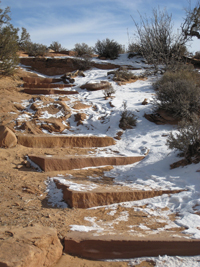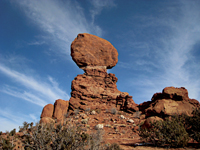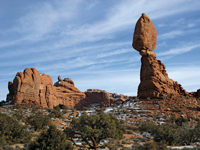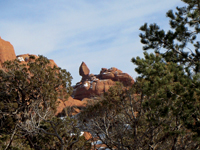HIKING HAPPENINGS FEBRURAY 2012
Balanced Rock – What Are The Odds?
article and photos by Marcy Hafner
Endowed with the largest concentration of natural sandstone arches on this planet, Arches National Park also provides an equally stunning display of spectacular red rock configurations. Within its 119 square miles, a geological bounty of colossal fins, soaring pinnacles, massive domes and balanced rocks of all sizes exist. The park’s granddaddy of balanced rocks, however, is the well-known Balanced Rock, a prominent landmark that can be seen for a long distance.
 The dimensions of Balanced Rock are staggering. Its base is 73 feet high. The upper section - the balancing boulder - extends up another 55 feet and weighs in at a whopping 3,500 tons! Considering the massive bulk of this huge hunk of rock, the juggling act I am witnessing doesn’t seem possible. The dimensions of Balanced Rock are staggering. Its base is 73 feet high. The upper section - the balancing boulder - extends up another 55 feet and weighs in at a whopping 3,500 tons! Considering the massive bulk of this huge hunk of rock, the juggling act I am witnessing doesn’t seem possible.
The harder caprock layer of the Slickrock Member within the Entrada Sandstone of Balanced Rock sits upon the softer mudstone layer of the Dewey Bridge Member. As the lower level weathered more quickly, the end result was a smaller pedestal tenaciously supporting the larger mass of rock above. But only for a bare instant in geologic time - erosion never gives up - sooner or later every balanced rock plummets to the ground. Chip Off The Old Block, a nearby smaller balanced rock, fell during the winter of 1975-76.
Our arid climate, alternating softer and harder rock layers and the lack of earth tremors provide ideal conditions for the formation of balanced rocks. But even with the right ingredients, balanced rocks are still nature’s long shots. With astronomical odds against them, only by sheer chance have these extreme gambles paid off - a few winners that survived to perform the seemingly impossible feat of staying upright. In order for this geological trick to happen, the rate of erosion must be perfect - wearing so evenly that, rather than tipping over, the boulder instead remains perfectly balanced.
The entrance to Arches National Park is five miles north of Moab on Highway 191, and  the parking area for Balanced Rock is nine miles further up the main road. A seven day pass costs $10.00 per vehicle and $5.00 for bicyclists, walk-ins and motorcycles. An annual pass for Arches, Canyonlands National Park, Hovenweep National Monument and Natural Bridges National Monument can also be purchased for $25.00. Open year round, Arches is least crowded in the winter, and camping, which has centrally located flush toilets, potable water, picnic tables and grills, is available at the Devils Garden Campground for $10.00 per night. the parking area for Balanced Rock is nine miles further up the main road. A seven day pass costs $10.00 per vehicle and $5.00 for bicyclists, walk-ins and motorcycles. An annual pass for Arches, Canyonlands National Park, Hovenweep National Monument and Natural Bridges National Monument can also be purchased for $25.00. Open year round, Arches is least crowded in the winter, and camping, which has centrally located flush toilets, potable water, picnic tables and grills, is available at the Devils Garden Campground for $10.00 per night.
From a long distance the distinctive silhouette of Balanced Rock gives the illusion of being much smaller than it really is. Only when I’m walking on the short loop trail for a closer inspection do I understand the true dimensions of this impressive formation, which is most definitely much bigger than its original portrayal would suggest.
 At 5,000 feet in elevation the slight biting breeze on this nippy sparsely cloudy day makes for a chilly walk around Balanced Rock as I wander through the trademark high desert vegetation of junipers, pinyons, oaks, cliffrose, Mormon tea and blackbrush. The deep booming calls of ravens capture my attention, and I glance upward to watch their high-in-the sky flight. During the winter exodus when all other birds have departed for the handouts in town or a warmer environment further south, I can always count on seeing ravens. No matter how bitter the weather, these hardy corvids always stick around. At 5,000 feet in elevation the slight biting breeze on this nippy sparsely cloudy day makes for a chilly walk around Balanced Rock as I wander through the trademark high desert vegetation of junipers, pinyons, oaks, cliffrose, Mormon tea and blackbrush. The deep booming calls of ravens capture my attention, and I glance upward to watch their high-in-the sky flight. During the winter exodus when all other birds have departed for the handouts in town or a warmer environment further south, I can always count on seeing ravens. No matter how bitter the weather, these hardy corvids always stick around.
This extremely easy one-third mile trail starts out on concrete, which to me feels like an interstate. Then it travels up some slickrock to a few man-made sandstone steps that swing around to the snow packed shady side. Instantly the deep freeze sets in, and I hastily remove myself from Balanced Rock’s frigid shadow.
Even though I have a front row seat to observe the star of the show, the entertainment definitely doesn’t stop with the main event. This outdoor theater is mostly empty, and with no distractions I have the opportunity to become deeply engrossed in this spectacular full screen performance - a mini-sized balanced rock, endless topsy turvy sandstone formations, an arch and an assortment of hard rock spires that thrust up from the ground like gigantic thumbs. Beyond the park the sheer ragged edges of the Moab Rim are a definitive outline along the western edge of Moab Valley, while the contrasting snow-white profiles of the La Sal and Abajo Mountains highlight the far distant horizons.
 During my walk around this imposing structure, I notice a drastic change in its appearance. On the well-known photogenic front side it looks so cohesive and dignified. But when I swing over to the backside, its features take on a whole new personality - a rock structure that now suggests a big head on an extremely thin neck, which is way out of proportion to the rest of its body. While studying the layers in the scrawny neck, I am incredulous at its tremendous strength and stability that keeps this oversized head in place! During my walk around this imposing structure, I notice a drastic change in its appearance. On the well-known photogenic front side it looks so cohesive and dignified. But when I swing over to the backside, its features take on a whole new personality - a rock structure that now suggests a big head on an extremely thin neck, which is way out of proportion to the rest of its body. While studying the layers in the scrawny neck, I am incredulous at its tremendous strength and stability that keeps this oversized head in place!
Balanced rocks are fascinating subjects, and I am most content to stick around for a long time to savor this immense icon in its quiet off-season mood. In the meager warmth of the winter sun, it’s a pleasurable time of solitude when I have the undisturbed chance to study this incredible phenomenon and its amazing balancing capabilities.
|
Biological Soil Crust (aka)
Cryptos (krip’ tose):
The surface of
Moab’s desert is held
together by a thin skin of living organisms known as cryptobiotic
soil or cryptos. It has a lumpy black appearance, is very
fragile, and takes decades to heal when it has been damaged.
This soil is a critical part of the survival of the desert.
The cryptobiotic organisms help to stabilize the soil, hold
moisture, and provide protection for germination of the seeds
of other plants. Without it the dry areas of the west would
be much different. Although some disturbance is normal and
helps the soil to capture moisture, excessive disturbance
by hooves, bicycle tires and hiking boots has been shown
to destroy the cryptobiotic organisms and their contribution
to the soil. When you walk around Moab avoid crushing the
cryptos. Stay on trails, walk in washes, hop from stone to
stone. Whatever it takes, don’t crunch the cryptos
unless you absolutely have to! |

Cryptobiotic soil garden
|
|
|
 The dimensions of Balanced Rock are staggering. Its base is 73 feet high. The upper section - the balancing boulder - extends up another 55 feet and weighs in at a whopping 3,500 tons! Considering the massive bulk of this huge hunk of rock, the juggling act I am witnessing doesn’t seem possible.
The dimensions of Balanced Rock are staggering. Its base is 73 feet high. The upper section - the balancing boulder - extends up another 55 feet and weighs in at a whopping 3,500 tons! Considering the massive bulk of this huge hunk of rock, the juggling act I am witnessing doesn’t seem possible. the parking area for Balanced Rock is nine miles further up the main road. A seven day pass costs $10.00 per vehicle and $5.00 for bicyclists, walk-ins and motorcycles. An annual pass for Arches, Canyonlands National Park, Hovenweep National Monument and Natural Bridges National Monument can also be purchased for $25.00. Open year round, Arches is least crowded in the winter, and camping, which has centrally located flush toilets, potable water, picnic tables and grills, is available at the Devils Garden Campground for $10.00 per night.
the parking area for Balanced Rock is nine miles further up the main road. A seven day pass costs $10.00 per vehicle and $5.00 for bicyclists, walk-ins and motorcycles. An annual pass for Arches, Canyonlands National Park, Hovenweep National Monument and Natural Bridges National Monument can also be purchased for $25.00. Open year round, Arches is least crowded in the winter, and camping, which has centrally located flush toilets, potable water, picnic tables and grills, is available at the Devils Garden Campground for $10.00 per night.  At 5,000 feet in elevation the slight biting breeze on this nippy sparsely cloudy day makes for a chilly walk around Balanced Rock as I wander through the trademark high desert vegetation of junipers, pinyons, oaks, cliffrose, Mormon tea and blackbrush. The deep booming calls of ravens capture my attention, and I glance upward to watch their high-in-the sky flight. During the winter exodus when all other birds have departed for the handouts in town or a warmer environment further south, I can always count on seeing ravens. No matter how bitter the weather, these hardy corvids always stick around.
At 5,000 feet in elevation the slight biting breeze on this nippy sparsely cloudy day makes for a chilly walk around Balanced Rock as I wander through the trademark high desert vegetation of junipers, pinyons, oaks, cliffrose, Mormon tea and blackbrush. The deep booming calls of ravens capture my attention, and I glance upward to watch their high-in-the sky flight. During the winter exodus when all other birds have departed for the handouts in town or a warmer environment further south, I can always count on seeing ravens. No matter how bitter the weather, these hardy corvids always stick around.  During my walk around this imposing structure, I notice a drastic change in its appearance. On the well-known photogenic front side it looks so cohesive and dignified. But when I swing over to the backside, its features take on a whole new personality - a rock structure that now suggests a big head on an extremely thin neck, which is way out of proportion to the rest of its body. While studying the layers in the scrawny neck, I am incredulous at its tremendous strength and stability that keeps this oversized head in place!
During my walk around this imposing structure, I notice a drastic change in its appearance. On the well-known photogenic front side it looks so cohesive and dignified. But when I swing over to the backside, its features take on a whole new personality - a rock structure that now suggests a big head on an extremely thin neck, which is way out of proportion to the rest of its body. While studying the layers in the scrawny neck, I am incredulous at its tremendous strength and stability that keeps this oversized head in place! 